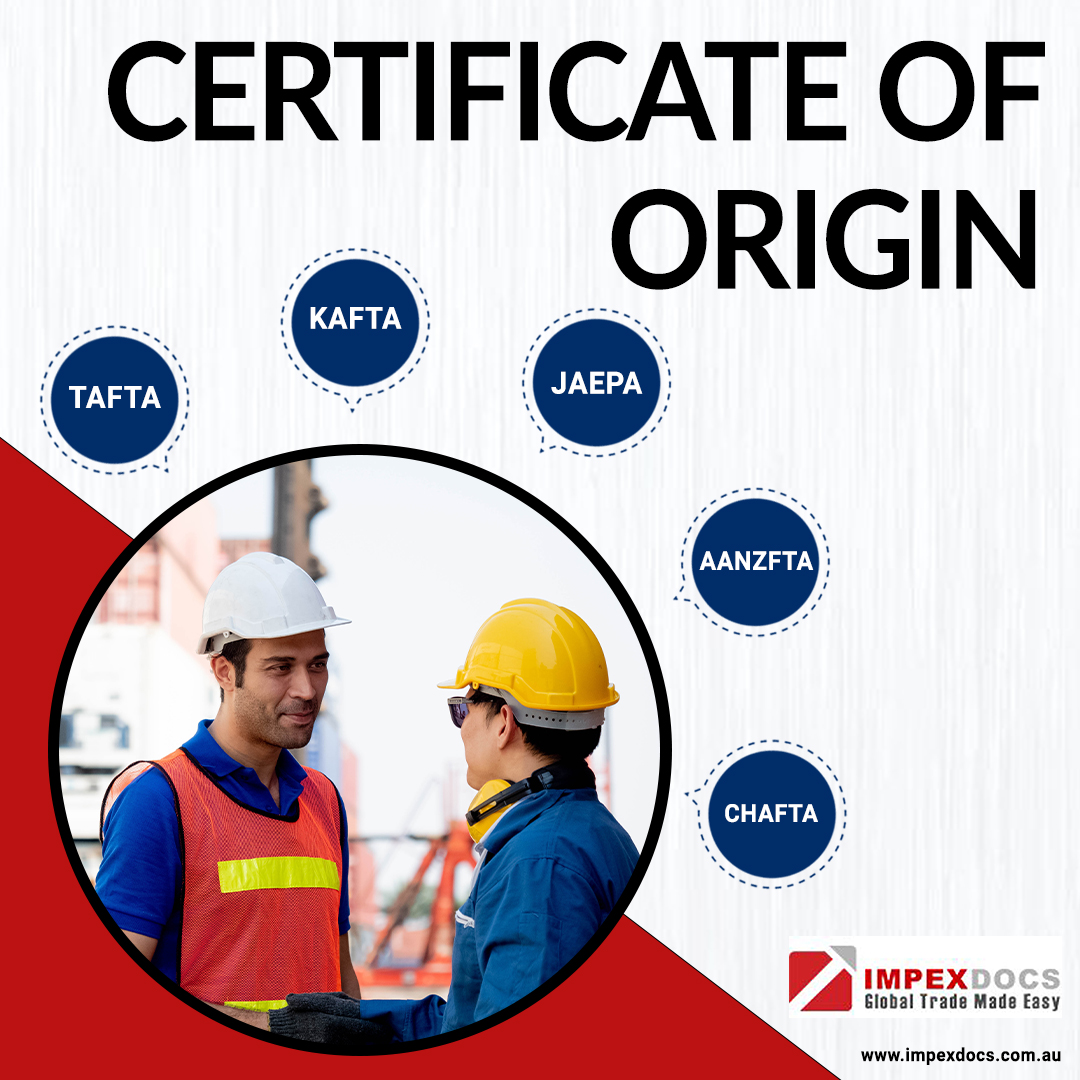
21 Jan
Your export business in Australia may be exporting different types of goods. For example, there can be goods entirely produced, manufactured or grown in Australia. Then, there can be another category of goods prepared in Australia using raw materials imported from some other country. Also, there can be goods imported from some other country, undergoing value addition in Australia and then re-exported.
So, the thing that matters while exporting goods in each of these categories is their origin. There are many parties that might have an interest in knowing where the goods actually belong to:
- Firstly, your importer and the import authorities in his/her country
- Secondly, the Customs
- Thirdly, the banks issue the letter of credits to the importers and so on
And, to cater to their interests, you must produce an important export document called the certificate of origin. In case you are reading this term for the first time, the following guide would help you to understand:
- What is the certificate of origin?
- What is its importance?
- Who issues the certificate?
- How to obtain it?
Let’s begin by answering the second question first
What Is the Importance of a Certificate of Origin?
Undoubtedly, the global trade setup has become highly complex over all these years. At the same time, countries that are trade partners often indulge in activities and agreements to promote their trade relationships. For instance, Australia has a number of Free Trade Agreements (FTAs) in force with many of its trading partners to facilitate preferential tariffs.
In simple words, preferential tariffs are the Customs duties less than the normal rates. Usually, two trading countries mutually endorse these tariffs to benefit the exporters as well as the importers. In many cases, the tariffs are reduced to zero for a number of export goods.
However, the FTAs don’t entitle every export good for preferential tariffs. Also, it is important that an exporter proves that his/her goods, entitled to receive these tariffs, have their origination point in his/her country only.
So, a certificate of origin serves two purposes:
- First, it certifies that the good in question is eligible to receive the benefits under an FTA
- Second, it validates that the good in question originated in one of the two countries entering that particular FTA
Now, it makes sense to answer the first question of this discussion.
What Is Certificate of Origin?
In the very simple language, a certificate of origin is an export document that certifies the origin (growth, production, manufacture etc.) of the goods intended for export from one country to another. To be specific, a certificate of Australian origin is an export document that certifies that the goods intended for export to countries (with which Australia has FTAs in force) originated in Australia.
Furthermore, a certificate of origin is of two types:
- Preferential: A preferential certificate of origin specifically aims at receiving preferential tariffs under one or the other FTA. With the help of this certificate, an importer enjoys the overall reduced costs of importing goods and thereby, making better profits. In addition, an exporter enjoys the benefits like more competitiveness and demand for its goods in the foreign markets. Lastly, it helps two trading countries to mutually improve their trade activities.
- Non-preferential: Apart from facilitating preferential tariffs, a certificate of origin may have other purposes to serve. So, a non-preferential certificate of origin can serve these purposes even for those goods that are not prescribed under any of the FTAs. For example, an importer may simply demand it only because Australia-originating products are in more demand in his/her region.
Also, this certificate may act as a guarantee from an exporter to the bank he/she borrows funds from to support importing. The bank may demand this certificate to issue a letter of credit. In this case, a non-preferential certificate of origin is what you may need to provide to your importer.
Coming back to the importance of a certificate of origin, you can now conclude that without it, you can’t:
- Meet the FTA requirements for preferential tariffs
- Get clearance from the Customs
- Promote great trade relationships globally
- Above all, enhance your export business’s profits and reputation
Who Issues Certificate of Origin?
In Australia, the following bodies have the authorization to issue certificates of origin:
- Australian Chamber of Commerce and Industry (ACCI)
- Australian Industry Group (Ai Group)
- The Australian Grape and Wine Authority
The ACCI operates a number of regional offices, called Chambers of Commerce, to accomplish the task with ease. These include:
- New South Wales – NSW Business Chamber
- Northern Territory – Chamber of Commerce NT
- Victoria – Victorian Chamber of Commerce and Industry
- Queensland – Queensland Chamber of Commerce and Industry
- South Australia – Business SA
- Western Australia – Chamber of Commerce and Industry of Western Australia.
- Freemantle Chamber of Commerce and Industry
- Bunbury Geographe Chamber of Commerce & Industry
- Tasmania – Tasmanian Chamber of Commerce & Industry
- Australian Capital Territory – Canberra Business Chamber
Besides, the ACCI also authorizes the Australian Arab Chamber of Commerce and Industry for issuing the certificate in the regions like Victoria and Queensland.
How to Obtain a Certificate of Origin?
First of all, you must register with a Chamber of Commerce in your region. Clearly, you must register for a specific FTA, depending on the country you want to export to. For example, you must register for:
- TAFTA for exporting to Thailand
- ChAFTA for exporting to China
- JAEPA for exporting to Japan and so on
To register, you must fill out the Exporter Information Form (Form CO4), providing details about your business. Also, the form must mention the people you want to nominate as signatories for certificates of origin.
Every time you need a certificate, you just need to follow the below steps:
- Type a certificate of origin, providing details about your consignment (departure date, port of loading, HS code, weight etc.)
- Attach the required documents like evidence of origin (that can be a bill of adding, invoice etc.)
- Sign the certificate at the prescribed spot
- Always submit an additional copy for the chamber’s records
It is recommended to follow the process for electronic documentation to save time as well as costs.


